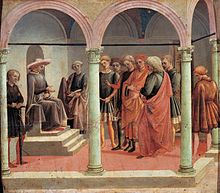Francesco Pesellino
Francesco di Stefano , called Pesellino (* probably 1422 ; † July 29, 1457 in Florence ) was a painter in Florence during the Renaissance . He is close to the style of his Florentine contemporary Fra Filippo Lippi and painted small-format paintings with religious themes. He is also credited with painting some of the bridal chests (cassoni) known to connoisseurs .
Il Pesellino
Francesco di Stefano was known as Il Pesellino , Francesco Pesellino , or Francesco di Stefano Pesellino . He was the son of the painter Stefano di Francesco and after the death of his father in 1427 he lived with his maternal grandfather Giuliano Pesello (* 1367, † 1446), who was also a painter. He then got the surname Il Pesellino and also used the name Francesco Pesellino himself .
Style and workshop
After initial training, presumably by his grandfather, Pesellino is said to have run their own workshop in Florence with Piero di Lorenzo and Zanobi di Migliore in Corso degli Adimari (now Via dei Calzaiuoli ). Perhaps he was also a student of Fra Filippo Lippi in between , in any case he is considered to be very influenced by him.
Pesellino mainly created small-format religious works and bridal chests ( cassoni ) painted with scenes from myths and legends. His style is close to that of his Florentine contemporary Lippi, whose workshop is said to have completed one of his unfinished works even after Pesellino's untimely death. Pesellino's style of painting anticipated the development of subsequent Florentine painters such as Verrochino and Pollaiuoli .
Works (selection)
painting
-
Trinity Altar ( Trinity Altar of Pistoia) 1455–1460, National Gallery, London
- Pesellino's Trinity Altar is his only documentary work that can be reliably assigned. It was commissioned from him by a college of priests from Pistoia in September 1455 and was not yet completed when he died. It was completed by Lippi or his workshop until 1460.
-
Predella with the birth of Christ and scenes from the life and martyrdom of saints.
- Vasari reports in the 16th century about Pesellino's predella on an altar by Lippi for the church of Santa Croce in Florence. Probably sawn into six parts in the 18th century, these are now divided between the Uffizi Gallery, Louvre and Accademia Carrara Bergamot.
- More paintings
- Mary with child and saints . Louvre, Paris
- Mary with the child and six saints . Metropolitan Museum of Art, New York
- Annunciation . The Courtauld Gallery, London
- Crucifixion . National Gallery of Art, Washington
- The miracle of St. New Year's . Worcester Art Museum (possibly part of the Predella)
- The construction of the temple . Fogg Art Museum (attributed to Pesellino or Pesellino successor)
Cassoni (bridal chests)
Cassoni (attributed)
- Triumph of david . National Gallery, London
- Triumph of love, chastity and death . Isabella Stewart Gardner Museum, Boston
- Triumph of Petrarch . Isabella Stewart Gardner Museum, Boston.
- The life of the Griseldis . Galleria dell'Accademia Carrara ,. Bergamo.
Book illumination
From a series of six pictures with allegories
- Rome , around 1448. Hermitage, Saint Petersburg
- Carthage , around 1448. Hermitage, Saint Petersburg
literature
- W. Weisbach: Francesco Pesellino and the Romanticism of the Renaissance . Berlin, Cassirer, 1901
- A. Scharf: On the art of Francesco Pesellino . In: Pantheon, 14.1934, pp. 211-221
- U. Schlegel: A Madonna picture by Francesco Pesellino . In: Low German contributions to art history, 2.1962, pp. 172–178
- D. Gordon: The 'missing' predella panel from Pesellino's Trinity altar-piece . In: The Burlington magazine, 138.1996, p. 87-88
- Francesco Pessellino . In: Fogg Art Museum (Ed.): Collection of Mediaeval and Renaissance Paintings. Kessinger Publishing, 2004. pp. 61-64
- Giorgio Vasari : The life of Lippi, Pesello and Pesellino, Castagno, Veneziano and Fra Angelico. Newly translated into German by Victoria Lorini. Ed., Commented by, introduced by Jana Graul and Heiko Damm. Verlag Klaus Wagenbach , Berlin 2011, ISBN 978-3-8031-5054-7 .
Web links
Individual evidence
- ↑ Francesco Pesellino. In: Paintings The National Gallery London www.nationalgallery.org (accessed February 2010)
- ^ A. Scharf: On the art of Francesco Pesellino. In: Pantheon, 14.1934, pp. 211-221
- ^ D. Gordon: The Fifteenth Century Italian Paintings , Volume 1 National Gallery Catalogs 2003, p. 260
- ↑ G. Vasari, Giorgio, Le Vite de 'piú eccellenti pittori scultori ed architettori da Cimabue insino a' tempi nostri. Florence, Torrentino, 1550 (revised 1568)
- ↑ cf. A. Ten Eyck Gardner: Beckford's gothic Wests. In: The Metropolitan Museum of Art bulletin, NS 13.1954 / 55,1, pp. 41–49
- ↑ Francesco Pessellino. In: Fogg Art Museum (Ed.): Collection of Mediaeval and Renaissance Paintings. Kessinger Publishing, 2004, p. 62
- ↑ cf. F. Ames-Lewis: Francesco Pesellino's "Story of David" panels in the National Gallery. In: Biuletyn historii sztuki, 62.2000, p. 189-203
- ↑ Isabella Steward Gardener Museum: The Triumph of Marriage, painted cassoni of the renaissance, October 16, 2008 - January 18 . 2009 Boston MA (Massachusetts, USA) 2008 Exhibition catalog / press release (English) ( Memento of the original from October 1, 2009 in the Internet Archive ) Info: The archive link has been inserted automatically and has not yet been checked. Please check the original and archive link according to the instructions and then remove this notice.
- ↑ cf. LS Malke: Contributo alle figurazioni dei Trionfi e del Canzoniere del Petrarca. In: Commentari, 28.1977,1 / 3, p. 236-261
- ↑ cf. B. Uppenkamp: Griselda - a fairy tale about the civilizing power of humility. In: AM Bonnet, B. Schellewald: Women in the early modern age: Lifestyles in art and literature: Böhlau, 2004
| personal data | |
|---|---|
| SURNAME | Pesellino, Francesco |
| ALTERNATIVE NAMES | Stefano, Francesco di |
| BRIEF DESCRIPTION | Italian Renaissance painter |
| DATE OF BIRTH | uncertain: 1422 |
| DATE OF DEATH | July 29, 1457 |
| Place of death | Florence |




